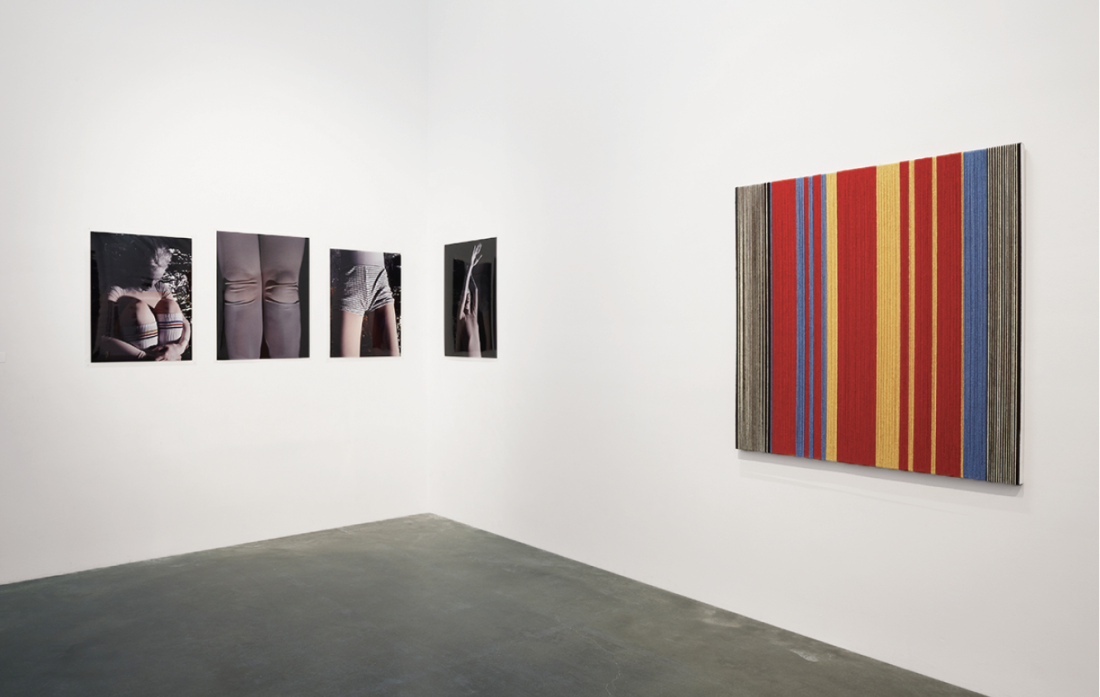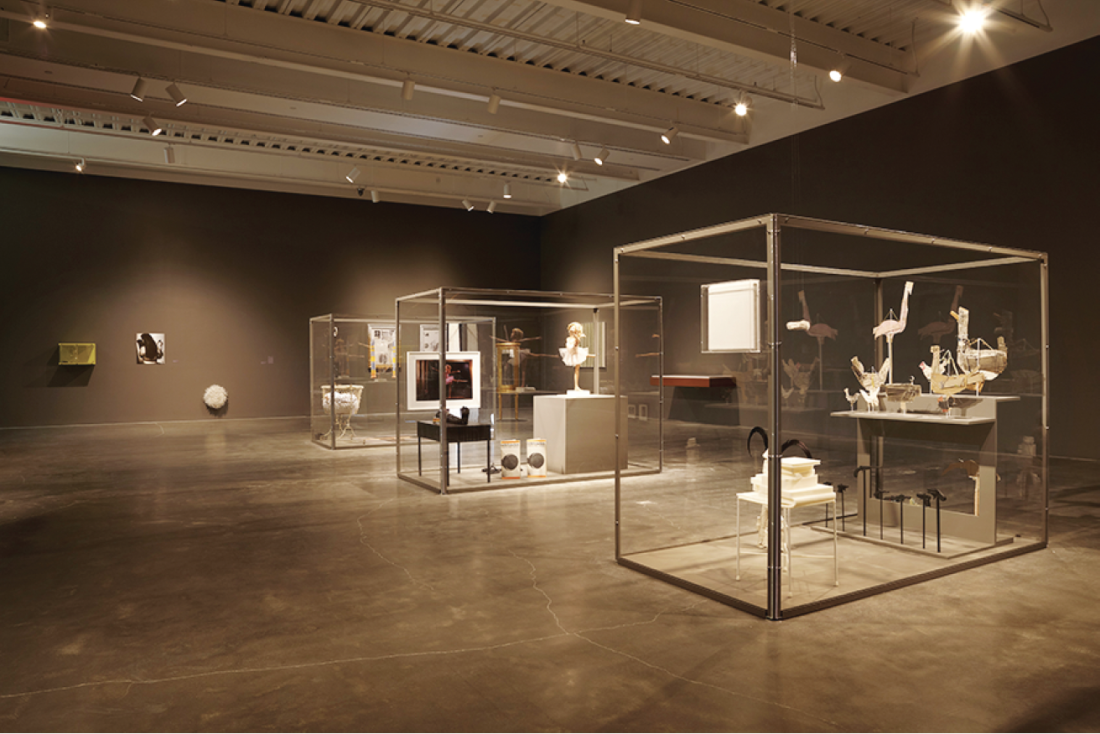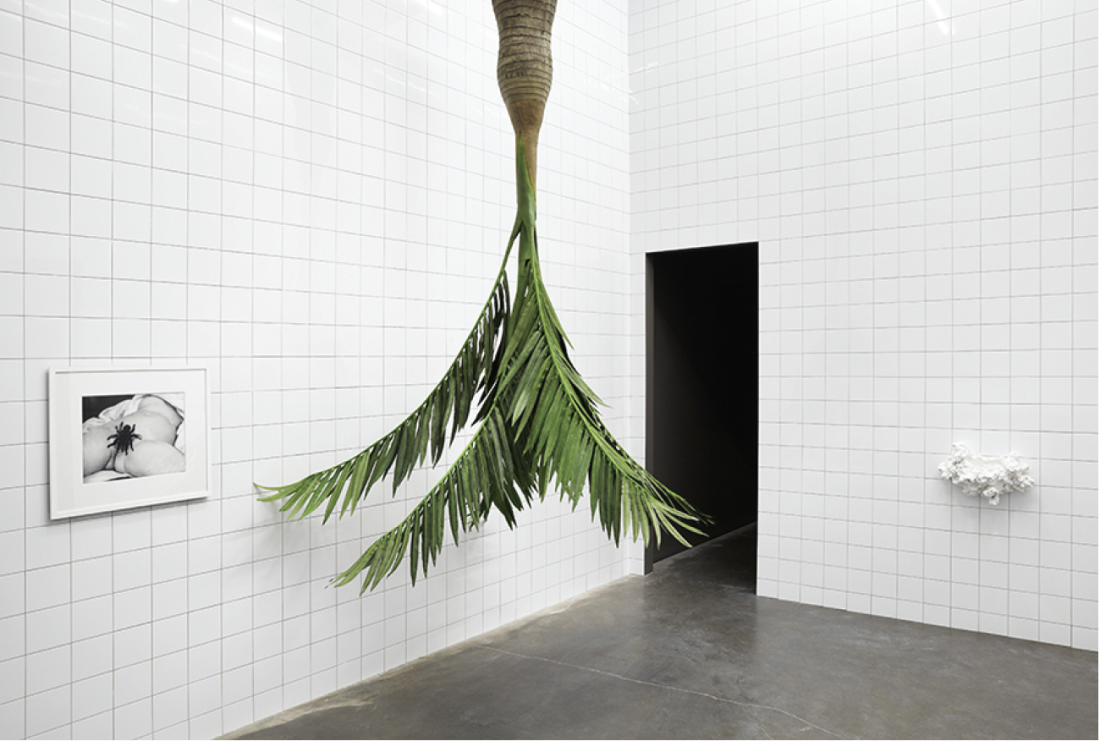Rosemarie Trockel
One of the principal criteria for an artist’s being significant is that he or she creates not just individual works that are beautiful or original or engaging, but rather assembles a body of work that articulates an encompassing and singular vision of the world and our place in it. If art is to be something more than decorative, if it is to be something beyond a brief intervention into the aesthetic and social issues of a particular time and place, then it has, of necessity, to be speculative and visionary. This is as true of Titian and Rembrandt as it is of Willem deKooning, Robert Rauschenberg and Joseph Beuys.

“Rosemarie Trockel: A Cosmos,” installation view. Left wall: “From a French Magazine” series, 2005. Right wall: Dress – Stage 2, 2012, wool, 127 x 127 cm. Image courtesy the New Museum, New York. Photograph: Benoit Pailley
Born in Schwerte, Germany and educated at the Werkkunstschule in Cologne, Rosemarie Trockel, who turned 60 in November and whose career has been both distinguished and highly idiosyncratic, almost certainly belongs in this company. And “Rosemarie Trockel: A Cosmos,” curated by Lynne Cooke of the Museo Nacional Centro de Arte Reina Sofia in Madrid, in close collaboration with the artist, which occupied three floors of the New Museum in New York through January 20, is a perfect introduction to this artist’s vision of the world. The exhibit is not a retrospective and hardly encyclopedic. Rather, it includes important selections of core aspects of the artist’s work, as well as an eccentric and illuminating sampling of artworks and artifacts that have, in one way or another, inspired her.
Trockel emerged as an artist in the late 1970s in a Germany still haunted by the Second World War and racked by political upheaval, and in an art scene dominated by aggressive male painters like Anselm Kiefer, Sigmar Polke and George Baselitz. These were artists who worked solidly within the Western pictorial tradition, who more often than not worked on a vast scale and in the register of the tragic and the sublime. Trockel’s conceptually astute work, fueled in part by a feminist critique of the often bombastic and romantic view of creativity common among her contemporaries, has always resisted easy classification in terms of either style or medium: she has worked with ease in wool, ceramics, oil paint, photography, video and performance.

“Rosemarie Trockel: A Cosmos,” installation view. Image courtesy the New Museum, New York. Photograph: Benoit Pailley
The fourth floor of “A Cosmos” is devoted to Trockel’s ceramic works. Magma, 2008, for instance, consists of three lumpy, fragmented globs of ceramic, glazed blue, brown and black in a work that seems less like a work of art than evidence of our tumultuous geological history. Twin 1, 2008, is a granulated shard that looks like a rare specimen of crystal from some natural history museum, which is presumably the source of its title: crystal is the only non-living substance that replicates itself. Most of Trockel’s ceramic works are small and have an archaic quality, as though they had been discovered in some deep strata of a geological site or an archeological dig. Whereas an artist like Beuys’s use of fat and felt refers directly back to his experiences in the Second World War, Trockel’s use of material is quiet, subtle and multi-dimensional: these works at once resist the domineering presence of the artist’s hand, gesture toward women’s relationship to ceramics in the home and place the objects in a deeper, more ambiguous and primal relationship to the vicissitudes of time.
The museum’s third floor is devoted to Trockel’s works in machine-knitted wool stretched on frames. Trockel has been creating “knitting pictures” since the mid-1980s, originally using computer-generated geometrical motifs based on logos and national flags. The wool pieces included in “A Cosmos” are, by contrast, more recent in date, their tone more reflective than directly political. Sky, 2012, for instance, is simply an expanse of deep, twilight blue wool, while I See Darkness, 2012, is a striped black with shreds of purple and white. Silent Way, 2012, has a blue stripe running horizontally through the centre of the picture against a dark ground, while Time Cuts Us Into Pieces, 2012, is orange with darker bands running along the upper and lower edges. These are abstract images that allude directly to figures like Barnett Newman and Ad Reinhardt, but the fact that they are fashioned from wool not only allows them to refer to traditional women’s labour both in the factory and the home, but also gives them a tactility and intimacy that is familiar. Unlike paint, wool is a substance that we’re drawn to touch, even snuggle up against.

Rosemarie Trockel, Ceramic Room, 2012, ceramic tiles. Image courtesy the New Museum, New York
Perhaps the most compelling part of “Rosemarie Trockel: A Cosmos” is the section titled “Natural History” and located on the museum’s second floor, in which Trockel’s work figures least, forming a kind of cabinet of wonders of outsider artists and underappreciated figures and curious specimens. American Flamingo (Phoenicopterus Ruber), 1838, for instance, is a gorgeous etching with bright red aquatint by the early 19th-century painter and master printer Robert Havell, the flamingo’s agonizingly long neck arching all the way to the ground. Untitled (Ballerina), 1950/60, is one of the intricate, uncannily realistic and ultimately perverse dolls carved by Boston-based freelance photographer and graphic designer Morton Bartlett in his spare time. There are beautiful illustrated notebooks by Spanish outsider artist Manuel Montalvo, delicate birds created from scrap paper, wood and soot by American visionary James Castle and elegant tempera on paper plant drawings from the late 18th century by anonymous artists for the Royal Botanical Expedition to New Granada. If artists like Joseph Beuys and Anselm Kiefer seek a cosmic, sometimes apocalyptic, other times redemptive sublime, Trockel’s relatio_nship to the world is one of mystery and wonder. Even so, Trockel can’t resist throwing a feminist jibe. Replace Me, 2008, is an image of Gustave Courbet’s The Origin of the World with a tarantula placed over the woman’s sex. ❚
“Rosemarie Trockel: A Cosmos” was exhibited at The New Museum in New York from October 24, 2012 to January 20, 2013.
Daniel Baird is a Toronto-based writer on art, culture and ideas.

